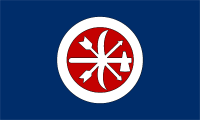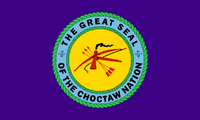Choctaw Youth Movement facts for kids
Quick facts for kids
Choctaw Youth Movement
|
|
|---|---|
 |
|
| Leader | Charles E. Brown |
| Founded | 1969 |
| Dissolved | c. 1975 |
| Ideology | Choctaw nationalism Self-determination Anti-termination Anti-Pan-Indianism Cultural revitalization Reservation sovereignty Native American civil rights |
The Choctaw Youth Movement (CYM) was a group of young Choctaw people. They started in the late 1960s. Their goal was to protect the Choctaw Nation from the US government's plan. This plan was called "termination." It would have ended the Choctaw Nation as a recognized tribe.
The CYM wanted to celebrate and protect their unique Choctaw culture. They were different from some other Native American groups. For example, they were not like the American Indian Movement (AIM). The CYM focused on peaceful actions. They wanted to bring back Choctaw language and traditions. They believed it was most important to be proud of being Choctaw.
Contents
Why Young Choctaws Spoke Up
Native American activists had been working for a long time. They wanted to protect tribal rights. In 1911, the Society of American Indians was formed. They worked to protect Native legal and cultural rights. They also wanted to change the Bureau of Indian Affairs.
Later, in 1944, the National Congress of American Indians was created. This group encouraged tribes to work together. They focused on what tribes had in common. One of its founders was Ben Dwight. He was a lawyer for the Choctaw Nation.
In 1961, a meeting was held in Chicago, Illinois. Native leaders created a plan called "Declaration of Indian Purpose." This plan was made by Native Americans for Native Americans. They gave it to President John F. Kennedy.
After this, the National Indian Youth Council (NIYC) was formed. They wanted to turn ideas into action. This group included young leaders from many tribes. They focused on respecting their elders. They wanted to keep traditions alive.
These early efforts helped inspire young people. The 1960s were a time of big changes. The Red Power movement and the American Indian Movement also grew. All these things led to a youth awakening in Oklahoma. The Choctaw Youth Movement was a big part of this. It had a lasting impact on the Choctaw people.
How the Movement Started

The 1960s saw a rise in awareness about minority rights. Important laws were passed. These included the Civil Rights Act of 1964 and the Voting Rights Act of 1965. During this time, a "pan-Indian" movement also grew. This movement wanted the US government to return Native lands. It also wanted to fix social problems.
The Red Power movement and American Indian Movement came from this. Many Native Americans had moved to cities. They felt isolated there. They found connection with other Native people. This led to a stronger sense of "Indian-ness." Young Choctaw activists in Oklahoma City, Oklahoma began to feel this too.
In 1969, the US government planned to "terminate" the Choctaw Nation. This plan was set for August 25, 1970. A young man named Jim Wade told Charles E. Brown about it. Brown was worried. He believed many Choctaw people did not know about this plan.
Brown started organizing other young Choctaw people. He went door to door in Oklahoma City. He used family connections to spread the word. They told people that the termination plan needed to be stopped. They also urged people to be proud of their Choctaw heritage.
By October 1969, they had help from Oklahomans for Indian Opportunity (OIO). OIO taught them how to lead and recruit. Brown then founded a group called OKChoctaws, Inc. It started for Choctaw people in the Oklahoma City area.
The group grew very fast. They soon needed a bigger meeting place. Within two years, the movement shifted. It moved from Oklahoma City to the Choctaw Nation homelands. Young people joined local groups in large numbers. They also took on leadership roles.
Fighting Against Termination
The activists created a newsletter called Hello Choctaws. It called itself the voice of the "average Choctaw." It often questioned the actions of Principal Chief Harry J. W. Belvin. The newsletter asked why average Choctaws didn't know about tribal land sales.
They sent Hello Choctaws to relatives across the US. Soon, OKChoctaws groups started in towns across the Choctaw Nation. These included Antlers, Atoka, and Talihina. Activists traveled to these towns. They spoke to young people there.
The activists made calls and sent letters of protest. They wrote to every member of Congress. They met with Oklahoma lawmakers. They also met with staff at the Bureau of Indian Affairs in Muskogee and Washington, DC. They gathered signatures for an anti-termination petition.
When the Secretary of the Interior spoke in Oklahoma City, hundreds of Choctaw attended. They let him know they did not want their tribe terminated. They also used their connections with OIO. They organized community activities. These included buying clubs for groceries. They also held meetings to teach political activism.
Chief Belvin saw these activities as "militant." He felt they challenged his authority.
Lasting Impact
It is hard to say exactly how much the Choctaw Youth Movement helped stop the termination law. The activists felt Chief Belvin supported termination. They thought he was against tribal goals. Belvin felt the activists were attacking him. He held meetings to explain his actions.
Public opinion was changing. The Indian Civil Rights Act of 1968 was passed. President Lyndon B. Johnson also spoke about "self-determination" for Native Americans. Belvin had been working to overturn the termination law for years. He also wanted tribes to elect their own leaders.
In these goals, Belvin and the youth activists were similar. After stopping termination, one of the activists' main goals was to elect their own tribal chief. They saw the government appointing their leaders as a threat to their identity as a sovereign people.
Belvin seemed to see the tribe as a business. He thought its role was to manage tribal money. Activists saw the tribe as much more. They believed it should help the community grow. They also wanted it to strengthen Choctaw identity. The movement clearly made Choctaw people proud to be Choctaw. It led to a rebirth of Choctaw nationalism.
Images for kids




